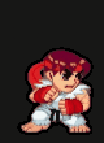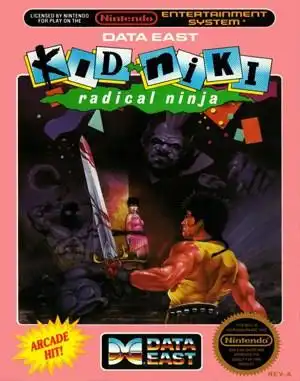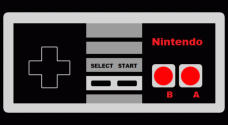Kid Niki: Radical Ninja - Spinning Through 80s Arcade Nostalgia
Cast your mind back to the late 1980s. The arcade scene was booming, and home consoles like the NES were bringing pixelated adventures into living rooms everywhere. Amidst the giants like Super Mario Bros. and Ghosts 'n Goblins, a plucky little ninja with a spinning sword burst onto the scene: Kid Niki: Radical Ninja.
While perhaps not as iconic as some of its contemporaries, Kid Niki holds a special place in the hearts of many who encountered its unique brand of side-scrolling action. Developed by Irem, the same company behind Kung-Fu Master, this game offered a distinct, if sometimes baffling, experience across arcades and various home platforms.
What Made Kid Niki... Radical?
At its core, Kid Niki: Radical Ninja is a classic 2D side-scrolling action-platformer. You play as the titular Kid Niki, a young ninja called to action when his girlfriend (or maybe just a friend?) is kidnapped by the evil Stone Wizard. The plot is simple, cheesy, and perfectly 80s, delivered via a brief, charming intro sequence.
Your primary weapon isn't shurikens or nunchucks, but a rather unique spinning sword. This isn't a typical slash; Niki spins his entire body, creating a brief, circular attack. It's got short range, but it's surprisingly effective against the waves of bizarre enemies the game throws at you.
Spinning into Action: Gameplay Mechanics
The gameplay loop is straightforward: move right, defeat enemies, jump over obstacles, and face a boss at the end of each of the seven stages. Enemies range from standard blue and red ninjas to birds, walking trees, and other strange creatures. Some are fodder, while others require careful timing to defeat or avoid.
Power-ups appear occasionally, often dropped by defeated enemies or found in bells. These can grant temporary abilities like a projectile attack or a protective shield. Mastering the spinning sword's range and timing is key, especially against bosses. A quirky mechanic against bosses is that a successful hit often causes your sword to fly off, requiring you to quickly retrieve it before you can attack again. This adds a layer of challenge and prevents simple button mashing.
Being an arcade game at heart, Kid Niki is relatively short. A skilled player can potentially see the end credits in under an hour, making it a perfect pick-up-and-play title for a quick dose of retro fun.
A Look Across the Ports
One of the interesting aspects of Kid Niki: Radical Ninja is its presence on multiple platforms, each with its own quirks:
- Arcade Original (Irem, 1986): The source material. Featured decent graphics for the time, memorable music, and voice samples for bosses. Known for being quite difficult, especially the Japanese version which sent you back to the start of the level upon death.
- Nintendo Entertainment System (NES/Famicom - Irem, 1987): Likely the most well-known version in North America. It captured the essence of the arcade game, with slightly simplified graphics and sound but retaining the core gameplay. The US NES version added checkpoints within levels, making it slightly more forgiving than the Japanese Famicom or arcade versions.
- Commodore 64 & Apple II (Quicksilver Software / Data East, 1988): These ports are... different. Developed by Quicksilver, they feature significant gameplay changes. Niki walks automatically, controls are remapped (up to jump, down to stop), and the screen flips instead of scrolling. Graphics and sound are also drastically different, often described as less polished than the console or arcade versions. They offer a fascinating, if sometimes awkward, alternative experience.
Comparing these versions highlights the challenges developers faced in bringing arcade experiences to diverse home computer hardware in the 80s. The C64 and Apple II versions, while perhaps not the best way to play, are certainly unique curiosities for retro computing enthusiasts.
Graphics and Sound: A Mixed Bag
Visually, Kid Niki is bright and colorful, though the animation is often quite basic, particularly in the NES and computer ports. Niki himself has limited frames of animation, giving him a somewhat stiff look as he runs and spins. Boss designs, however, tend to be more detailed and creative, adding some visual flair to the end of each stage.
The soundscape varies wildly between versions. The arcade and NES versions feature catchy, upbeat music that, while repetitive, fits the game's tone. The arcade even boasts some charmingly digitized voice clips for bosses. The computer ports, particularly the Apple II, have much more rudimentary sound, sometimes limited to simple beeps and short jingles. The C64 fares a bit better with more melodic sound effects, but neither matches the audio punch of the arcade or NES.
Why We Remember (Or Don't): Kid Niki's Legacy
Kid Niki: Radical Ninja landed in a crowded genre during a golden age for platformers. It didn't revolutionize gaming, and its somewhat generic "save the girl" plot and simple mechanics meant it was often overshadowed by more complex or polished titles.
Yet, its quirky protagonist, unique spinning attack, and memorable (if repetitive) music gave it a distinct personality. For many, it was a staple rental or a game played at a friend's house, contributing to a mosaic of nostalgic 80s gaming memories.
Today, you can revisit this piece of arcade history. The NES version is readily emulated, and the arcade version can be explored via MAME. The computer ports are also available through emulation platforms like DOSBox or specific system emulators, offering a glimpse into those less-common versions. While not a "must-play" classic for everyone, Kid Niki: Radical Ninja remains a fun, accessible slice of retro gaming that's worth a spin for the curious or the nostalgic.
FAQ
Q: What platforms was Kid Niki: Radical Ninja released on? A: It was originally an arcade game, then ported to the Nintendo Entertainment System (NES), Commodore 64, and Apple II.
Q: Is Kid Niki a difficult game? A: The arcade and Japanese Famicom versions are quite challenging due to sending you back to the level start upon death. The US NES version is slightly easier with checkpoints. The computer ports have their own unique difficulty curves due to different mechanics.
Q: Can I play Kid Niki: Radical Ninja today? A: Yes, you can play via emulation (like MAME for arcade, NES emulators, DOSBox for computer versions) or sometimes find official re-releases on modern platforms (check digital stores like GOG or platform-specific retro collections). Archive.org also hosts many older computer versions playable in-browser.
Q: Is there a sequel to Kid Niki? A: Yes, Irem released a sequel in Japan called Kaiketsu Yanchamaru 2: Karakuri Land (The Fantastic Kid Yanchamaru 2: Mechanical Land), which was later released in North America as Kid Niki 2 for the Game Boy. There was also a third game in Japan.


